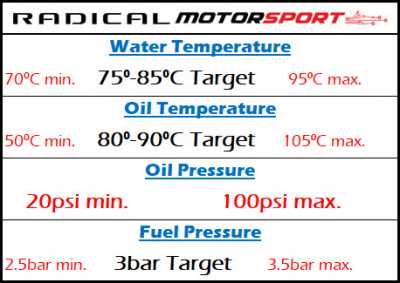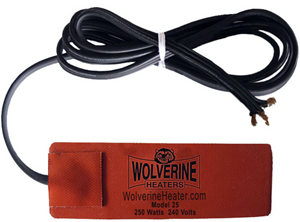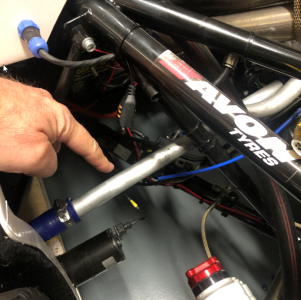
Normal running temperatures
New owner, can anyone tell me what I should see before pushing the car on track? Originally I was told 90-110 oil and 70-90 on water. REALLY difficult to get that oil temp in 65 degree ambient in a 20 minute session. Have almost then entire duct taped off and still barely getting there.
Looking through the mechanics manual v1.2 p7 it states that oil should be 70-115 and water 70-95. That seems more reasonable although I hit 94 on way back to pits and pushed some water out the swirl pot?
Thanks,
The owners manual for the SR3RS (Gen 2) recommends:
Oil: 60 to 130C
Water: 60 to 100C
The Owners manual and mechanics manual for the RSX have a little bit of a discrepancy... The owners manual recommends Pre-session temperatures of:
Oil: 90 to 110C
Water: 70 to 90C
And the Mechanics manual recommends Post-session temperatures of:
Oil: 70 to 115C
Water: 70 to 90C
Radical always recommends going with the information in the latest manuals so I would recommend using the information in the mechanics manual (with one caveat):
Oil: 70 to 115C (I think 90C is too conservative as long as your oil pressure is below 100psi)
Water: 70 to 90C
The Caveat is... Always watch your oil pressure for the first few laps out on track and make sure you keep the oil pressure below 100psi. Exceeding this pressure can cause blown coolers or other bad things.
Charley
Charley,
As always, I really appreciate the reply with great information. I've been following your recommendations and also had similar thoughts on keeping pressure below 100. Found a little short shifting 6k the first few laps allowed the oil to come up to temp while keeping pressure acceptable.
For other new comers I also found just taking a small 8-10" fan I had in our rv and directing it towards the radiator duct/inlet allowed running the car long enough to bring oil up to temp much sooner.
I'm seriously considering installing a thermostatically controlled fan on the radiator for coolant. Yes it's a few extra pounds but I think it'll be worth it.
I just got a response from a friend at Radical and he confirmed that the recommended On-track temperatures should be:
Oil: 90 to 110C
Water: 70 to 90C
He said that when they run the Factory team cars they warm them up to 50c before sending them on track and then it takes ~1 to 3 laps to warm up to operating temperatures.
Charley
Always preheat my car to 50c before going out, usually that means the water is somewhere around 70c, and unless it is a very cold day 2 laps bring the temperatures up to where they need to be. If buying a Radical the engine oil pre-heater is very useful.
Has anyone put a thermostat in the oil system .
Is there a thermostat in the engine?
All my Porsches use one ?
@slowcar, there isn’t a thermostat in the oil system and I have never heard of anyone adding one. The goal is to get all of the oil up to temperature prior to going out on track. That is why oil preheaters are so popular. If you open up your dry sump tank and shine a light in there while the engine is running you will be surprised at how much the oil is flowing.
No -- there is no thermostat -- either in the oil or the radiator. Since the oil is cooled via a liquid - liquid heat exchanger with the coolant, it's counter-productive to run a thermostat.
Let me see if I can explain that...
In order to go on track, Radical recommends minimum temps for the oil, coolant, and gearbox* (more on the gearbox below). If you keep engine heat out of the radiator (and therefore out of the heat exchanger) via a coolant thermostat, you'd keep the oil temps too low to go on track even when the coolant temps are within range.
It's better, then, to get as much engine heat into the coolant as quickly as possible so that it can help bring up the oil temps so that both are within operating range at around the same time. And usually, the coolant temps (even without a thermostat) get within range before the oil does. Oftentimes it's necessary to shut the car off and let the engine temps heat soak the coolant so that oil temps get within range. A thermostat would prolong this whole process since all the coolant needs to be at roughly the same temperature for the heat exchanger to keep the oil within the recommended range.
*The gearbox fluid is the same deal, Radical recommends a minimum temp before going on track. However the gearbox is cooled via an air-liquid heat exchanger, unlike the oil, and so the gearbox temps are often very low when the oil and coolant are ready to go. Many teams put the car on jacks and let the car idle in 6th gear as part of the warmup process to get around this problem. On my SR8, I've replaced the original gearbox cooler with a liquid-liquid heat exchanger so that the gearbox fluid is heated by the coolant along with oil. This also has the effect of slowing down how fast the coolant reaches operating temperature, so that the oil and gearbox fluid usually get to temp about as fast as the coolant.
Hope that makes sense!
Thanks for your reply's re thermostats and the great explanation John.
The company i bought my Sr3 RSX from in the UK is fitting a thermostat in the oil system on the cars they look after.
I will find out more information from them also.
@parsonsj - great information John.
I'm not sure if anyone else would be interested, but as another 'new owner' (used my car for the first time last month) I made and laminated a label for the dash - stuck with Velcro behind the steering wheel. Thought it would help at least until I get used to what I should be looking out for.
It's attached below if it helps others...
@slowcar An oil thermostat needs to have minimal pressure drop. MOCAL makes good stuff -- I wonder if that's what they are fitting?
@rjbender Love it! I'm stealing your idea!
Similar to that, I use the AiM LEDs on the dash (I have an MXS 1.2). Solid Red is too low, slow flashing is too high, and fast flashing is way too high.
I assign one LED per temp (coolant, oil, and gearbox) and one for pressure (oil). During normal track use, all the LEDs should be off. But if one comes on, I can tell right away if the temps or pressure is too low or too high. Usually, on my first lap or two, an LED remains solid on, and so I can drive more slowly (than usual, lol) until it goes out and I can go flat-out.
Further to my message a few minutes ago with the 'Dash Label' ... and while the subject of engine 'pre-heating' is being discussed, maybe I could ask if anyone has ever tried preheating the coolant as well as the oil?
I've heard and seen that there are systems that can be purchased, and hooked into the car by dry break couplings, that effectively heat the coolant (and oil?) in an off-board system.
I've gone a different route and just purchased another 'Wolverine' heat pad (same brand as that already fitted to the outside of my oil systems dry sump tank). This one is 250 watts and is 2.75"x6.75"
I'm going to stick it around the coolant pipe immediately after the water pump (the 1" aluminium tube that runs up to the back of the engine block)... It rises up toward the engine end, so I'm hoping as the water is heated inside the tube it will generate a thermo-syphon and pull cold water through the pump...
The tube has a circumference of approx. 3", while the heat pad is 2.75" wide, so should almost do a full lap around the tubes diameter without any overlap. The heat pad is 6.75" long and there is more than 12" of tube length exposed to stick it onto.
I'm hoping that by doing this I can simply plug my oil and water heaters in to my Honda generator, and this should speed up the whole warm up process....
Thoughts?
The coolant in my car comes up to temperature really fast, oil takes a while even with the wolverine preheater on the sump. Maybe that's due to the arctic temps we run in up here in Wisconsin though?
John's suggestion sounds like a good one. Does the gearbox recommendation apply to the GDU as well? Would make sense to have that fluid up to temp as well prior to entering the track.
Those with the experience seem to just run one on the oil sump. Warming to the upper end of the range and then short shifting to keep oil pressure below 100 for the first couple of laps seems to do the trick.
Where I run into problems is racing. My temps fall behind the pace car too much and also if we get a full course yellow for to long. I end up doing the short shift thing for a while again which doesn't help with lap times or the race effort.
Anyone up for designing variable block off plates for the air inlets that are adjustable from the cockpit? 🙂 Maybe I'm to picky but I spend way to much time taping and pulling tape off. Our temps can really very up here so maybe more of a problem than most see?
@rjbender, in my case I put the heat pad on the swirl pot and added a power pigtail to the water pump so it can be energized by my CTEK charger in supply mode (just like you do for fuel pump out) in order to allow the heated water to circulate and warm the whole lump up a bit. Combined with the oil reservoir heater I can get things warmed up pretty well before heading out.




